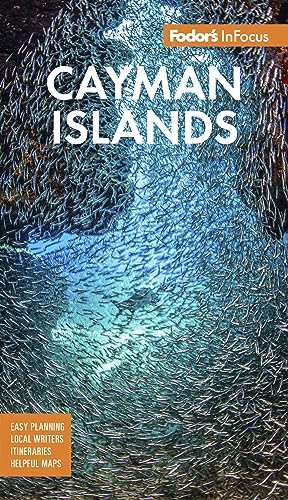Car
Driving is easy on Grand Cayman, albeit on the left. Traffic on the road from Seven Mile Beach to George Town then onto Bodden Town in Grand Cayman is terrible, especially during the 7 to 9 am and 4:30 to 6:30 pm commuting periods. One major coastal highway circumnavigates most of the island (one shortcut bisects the extensive East Districts), though you can get lost in the tangle of side roads in primarily residential West Bay. Exploring Cayman Brac on a scooter is fun and straightforward. You won't really need a car on Little Cayman, though there are a limited number of jeeps for rent; bikes are the preferred mode of transport.
Car Rentals
To rent a car in the Cayman Islands, you must have a valid driver's license and major credit card; you do not have to buy a separate local driving permit. Some companies set a minimum age of 25; drivers over 70 may need a certified doctor's note indicating a continuing ability to drive safely. Several dozen agencies rent cars, 4WD vehicles, and SUVs; rates are expensive—ranging from $45 to $95 per day (or $250 to $600 or more per week) in high season. Many firms offer significant discounts in low season, as well as reduced three-day rates. The rental generally includes insurance, pickup and delivery service (or shuttle service to your hotel or the airport), maps, 24-hour emergency service, and unlimited mileage. Car seats are usually available upon request.
The major agencies have offices to the left as you depart from the airport terminal in Grand Cayman; Andy's (a local, family-owned company) is to the right. All require that you walk outdoors for a hundred yards. Make sure your luggage is portable, because there's no shuttle. Many car-rental firms have free pickup and drop-off along Seven Mile Beach (or second branches) so you can rent just on the days you want to tour. Andy's has an office in East End; Cayman Auto Rentals, another local company, only has a location in George Town. Consider security when renting a jeep that cannot be locked. "Midsize" cars here often mean subcompact.
On Cayman Brac, the car-rental companies usually offer free pickup and drop-off at the airport and almost anywhere else if you don't rent your car on arrival or return it before you are ready to leave. All the companies are locally owned.
On Little Cayman you only have one option for car rentals, whether you rent for the day or the week.
Car Insurance
If you own a car, your personal auto insurance may cover a rental to some degree, though not all policies protect you abroad; always read your policy's fine print. If you don't have auto insurance, consider buying the collision- or loss-damage waiver (CDW or LDW) from the car-rental company, which eliminates your liability for damage to the car.
Some credit cards offer CDW coverage, but it's usually supplemental to your own insurance and rarely covers SUVs, minivans, luxury models, and the like. If your coverage is secondary, you may still be liable for loss-of-use costs from the car-rental company. But no credit-card insurance is valid unless you use that card for all transactions, from reserving to paying the final bill. All companies exclude car rental in some countries, so be sure to find out about the destination to which you are traveling.
Gasoline
In Grand Cayman, you can find gasoline stations in and around George Town, the airport, and Seven Mile Beach; a few remain open 24 hours a day. There are two gasoline stations on Cayman Brac and one on Little Cayman. Prices are exorbitant, even compared to those in the United States and most of the Caribbean, especially on the Sister Islands.
Parking
Park only in approved parking areas. Most hotels offer free parking. Many airports, Camana Bay, George Town, and Seven Mile Beach parking lots are free, but increasing development has prompted some major shopping centers to charge a fee if you park for more than 15 minutes (about $2.50 per hour); however, if you purchase something, parking should be validated and free. There is limited street parking, but watch for signs indicating private parking (in lots as well). Private enforcement companies are employed to discourage interlopers, placing a boot on the wheel and charging CI$75 for removal.
Road Conditions
Grand Cayman has well-paved roads that follow the coastline. A network of main highways and bypasses facilitates traffic flow into and out of George Town. Small signs tacked to trees and poles at intersections point the way to most attractions, and local people are helpful if you get lost. Remote roads are in good repair, yet lighting can be poor at night—and night falls quickly at about 6 pm year-round.
Cayman Brac has one major road that skirts the coast, with a shortcut (Ashton Reid Drive) climbing the Bluff roughly bisecting the island. Little Cayman also provides a coastal route; unpaved sections in less-trammeled areas can become almost impassable after heavy rain. Other than that, goats, chickens, cattle, and the occasional iguana have the right of way.
Roadside Emergencies
Each car-rental agency has a different emergency-assistance provider. In the event of theft, accidents, or breakdowns, call your car-rental agency and follow instructions.
Rules of the Road
Be mindful of pedestrians and, in the countryside, occasional livestock walking on the road. When someone flashes headlights at you at an intersection, it means "after you." Be especially careful negotiating roundabouts (traffic circles). Observe the speed limit, which is conservative: 30 mph (50 kph) in the country, 20 mph (30 kph) in town. George Town actually has rush hours: 7 to 9 am and 4:30 to 6:30 pm. Park only in approved parking areas. Always wear your seat belts—it's the law!




